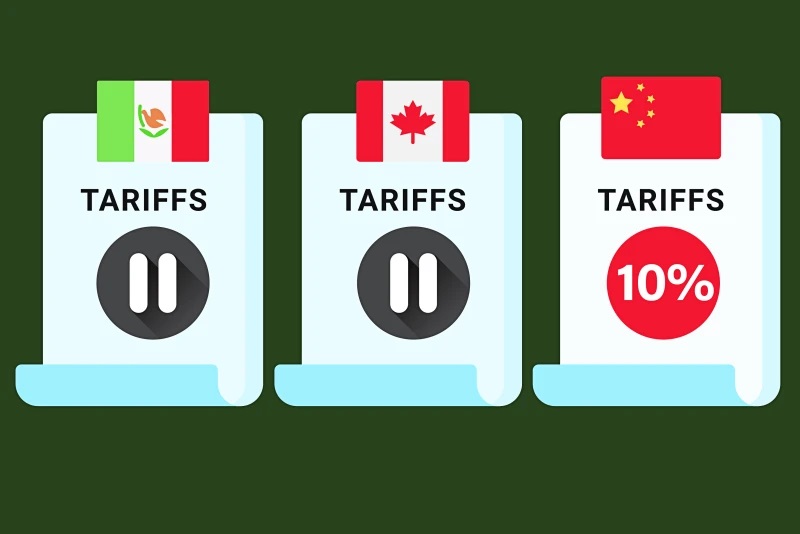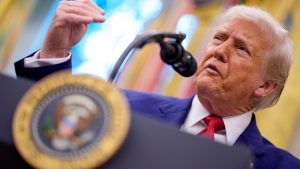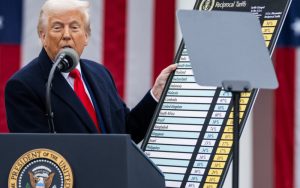
Who is next on the Trump administration’s trade radar?
As of Monday evening, Trump paused tariffs on Canada and Mexico, China tariffs continued to be discussed with China countering with tariffs on the U.S.
President Donald Trump agreed to pause tariffs on Mexican and Canadian goods after negotiations with Mexican President Claudia Sheinbaum and Canadian Prime Minister Justin Trudeau. The duties, originally set to take effect today, Feb. 4, will be postponed for at least 30 days while further discussions take place.
The notices on public review at the Federal Register on tariffs against Canada and Mexico are still shown as being on public inspection with a scheduled publication date on both being Feb. 5. It appears, at least for now, that Treasury Secretary Scott Bessent’s previous comments about Trump’s tariffs have proven correct. He described Trump’s strategy as “escalate to de-escalate,” implying levies are a negotiation tool.
Trump’s trade wants from Canada & Mexico include accelerated USMCA renegotiation.
Tariff suspension with Mexico.
“Tariffs will remain like Schrodinger’s cat, dead and alive at the same time. We believe the endgame is a USMCA renegotiation, to get a USMCA 2.0,” said Carlos Capistran, chief Canada and Mexico economist at Bank of America. “That is when the threat of tariffs really end.
Trump announced via social media that Sheinbaum agreed to deploy 10,000 Mexican soldiers to the U.S.-Mexico border to combat fentanyl trafficking and illegal migration. In exchange, the U.S. will hold off on imposing 25% tariffs on Mexican goods during a one-month negotiation period led by Secretary of State Marco Rubio, Treasury Secretary Scott Bessent, Commerce Secretary Howard Lutnick and himself. The U.S., in return, will strengthen efforts to stop the flow of weapons, including high-powered rifles, into Mexico, according to Sheinbaum. “For the first time, the government of the United States says we will work together to avoid high-caliber weapons from entering Mexico,” she said, referring to how cartels acquire many of their weapons illegally from the United States. Confirming the deal, Trump said the arrangement is mutually beneficial. Sheinbaum also announced Mexico would establish three joint working groups with the U.S. government. “We already have a working group with the U.S. State Department, where the undersecretary is actively engaged in defending our Mexican brothers and all immigration-related matters,”
Sheinbaum said. “Now, two new groups will be formed — one dedicated to security and another to trade,” she added, emphasizing the importance of the tariff pause. “We now have a month to work and convince everyone that this is the best path forward.”
U.S./Canada tariff freeze.
Trump and Trudeau agreed to a 30-day tariff suspension while they explore a broader economic deal. Trudeau confirmed Canada’s commitment to bolstering border security with $1.3 billion in funding, the assignment of 10,000 border personnel, the creation of a “Fentanyl Czar” to combat drug-related crime. The border protection plan will use new technology, personnel, helicopters, and enhanced cooperation with American law enforcement agencies. The nation is also investing $200 million in intelligence operations, appointing a fentanyl czar, designating cartels as terrorist organizations, and establishing a partnership with the U.S. Joint Strike Force to fight fentanyl trafficking, organized crime, and money laundering, Trudeau said. Talks with Trudeau also included discussions about regulations that prevent American banks from doing business in the northern nation, according to Trump.
China tariffs under discussion, but China reacts with tariffs on U.S. products.
“China will be dealt with,” Trump said. “China hopefully is going to stop sending us fentanyl, and if they’re not, the tariffs are going to go substantially higher.”
On Feb 3, China’s U.N. envoy suggested a meeting between Chinese Foreign Minister Wang Yi and U.S. Secretary of State Marco Rubio at an upcoming United Nations Security Council meeting in two weeks, stressing the need for cooperation because “so much is at stake.” China announced strong retaliatory measures against the U.S., imposing punitive tariffs of 10-15% on American products starting Feb. 10. This follows President Trump’s decision to levy 10% additional tariffs on Chinese goods, citing fentanyl controls. Beijing will apply:
- 15% tariffs on U.S. coal and natural gas
- 10% on petroleum, agricultural equipment, and high-emission vehicles
China’s Ministry of Finance condemned the U.S. move as a WTO violation that disrupts economic cooperation. Additionally, China introduced export controls on key minerals like tungsten and molybdenum and launched an anti-monopoly probe into Google. It also placed PVH (owner of Calvin Klein) and Illumina on its unreliable entity list, accusing them of discriminatory practices. Of note, despite the U.S. imposing a 10% tariff on Chinese goods and China retaliating with import taxes of up to 15%, the Chinese yuan remained stable, even returning to its previous Friday level. This unexpected resilience suggests that investors still hold hope for a potential last-minute negotiation or compromise, similar to the trade deferrals seen in Canada and Mexico. Trade with China has been falling since the first Trump administration, so the new U.S. tariffs may have only a limited effect on the economy.
Next on Trump’s trade radar
President Donald Trump has renewed his criticism of the European Union, accusing it of exploiting the U.S. on trade, particularly in autos and agriculture. “The European Union has abused the United States for years, and they can’t do that,” he said. In response, European leaders, including French President Emmanuel Macron, signaled their intent to push back. Given that the U.S. and the EU are each other’s largest sources of foreign direct investment, a trade battle between them could have serious economic consequences.
You can now read the most important #news on #eDairyNews #Whatsapp channels!!!
🇺🇸 eDairy News INGLÊS: https://whatsapp.com/channel/0029VaKsjzGDTkJyIN6hcP1K























